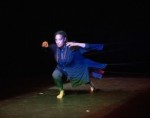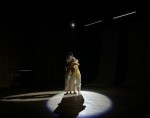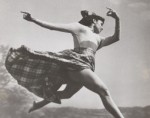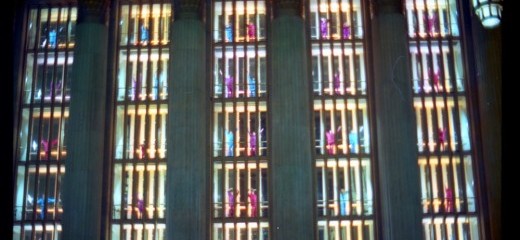
Koplowitz’s On Site: A Book Review and Conversation
by Jonathan Stein and Leah Stein
With the publication of Stephan Koplowitz’s book, On Site: Methods for Site-Specific Performance Creation, tD writer and editor Jonathan Stein and site-specific choreographer and dancer Leah Stein offer this conversation about the new book and the development of performance site work over the last three decades. Leah, a 2018 Pew Fellow, has had a career that parallels Koplowitz’s, creating site dances across the Philadelphia region and in Scotland, Poland, Romania and Japan. Jonathan has performed in many of Leah’s site works, and in Koplowitz’s first major site work, Fenestrations 3.0 (1991) (image above), reprised by Dancing in the Streets within 30th Street Station, Philadelphia.
Jonathan Stein: Leah, in considering Koplowitz’s new encyclopedic book on site-specific performance creation, I’m struck by both how recent in the history of dance has been this genre, and yet how as an outgrowth of post-modern dance it has now spanned over three decades. Your own career as a prolific site-specific choreographer has concurrently spanned this period. How do these two time frames strike you as an artist working in this field?
Leah Stein: In one sense, this field is not new at all, dance has always been outside. Not just in ancient or indigenous cultures, also in cultures where dance needed to happen even when there wasn’t space accessible. I guess I think of Rennie Harris’ history of Hip Hop presentation I attended years ago at IHouse in West Philly and all the dancing happening in the streets, on the corner. And, actually, that was probably the same era that early post-modern site artists started experimenting outside. The 60s and 70s is when the turn away from the proscenium became a movement. In the late 80s and early 90s, when Koplowitz and I started making site work, site artists focusing primarily on site work were emerging. My early influences were Eiko and Koma, Simone Forti, Deborah Hay, and Joanna Haigood.
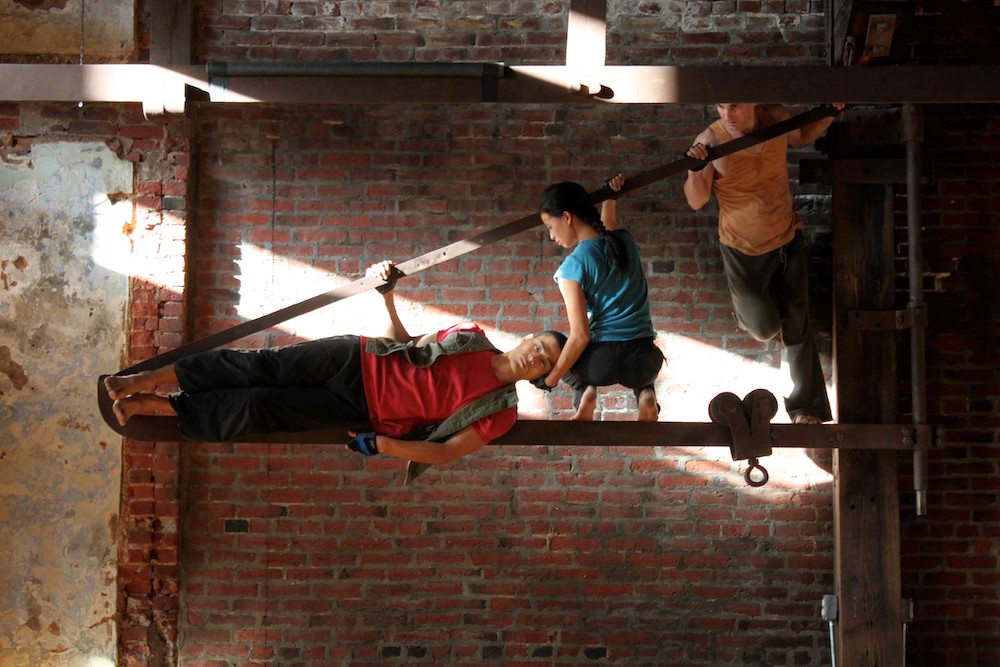
Hoist (2012), MAAS Building, Philadelphia, by Leah Stein, dancers: Jungwoong Kim, Michele Tantoco, David Konyk, Photo: Leah Stein
JS: I think the Koplowitz book pays homage to these influences as well as the breadth of creative, site-specific voices that have emerged over these years.
LS: More a movement than a genre, the approaches and aesthetics and values for site work are as vast as the individual artists engaged. With the range of voices and approaches he discusses, Koplowitz is able to touch on the numerous ideas and creative practices involved in the form and utilize his extensive knowledge and experience.
JS: Among a wealth of practical advice for site work creation are Koplowitz’s stimulating ideas for site selection and designing events for them, researching site histories and communities, and collaborations with associate artists. I wonder what struck you as especially helpful both for the emerging artist and the veteran one like yourself?
LS: The only antecedent reflecting the multiplicity of site work voices was Site Dance: Choreographers and the Lure of Alternative Space edited by Melanie Kloetzel* and Carolyn Pavlik. Among the many rich ideas Koplowitz discusses is the one in the quote from choreographer and dancer Amara Tabor-Smith: “You need to ask yourself what is my intent versus the impact?” This question is essential in making all work, and site work in particular. Site artists have a visible voice in the public realm, where there are different norms for different groups, who has access to what spaces, etc., and the question of the impact being aligned true to the intent is such an important consideration.
JS: This and other points in the book reflect a candor from Koplowitz that acknowledges that this public realm comes with a social responsibility, and requires a humility and sensitivity in asserting one’s values and vision; and as well, he acknowledges the privileges he has had as a white, financially secure artist to pursue his work.
LS: I liked his quote from New Zealand (Aotearoa) site artist Olive Bieringa of Body Cartography Project who reported a Black audience member responding: “Man, I just scratch my nuts and they take me to jail. What do you think you’re doing?” I appreciate that Koplowitz frankly acknowledges his own learning curve throughout the book. He also mentions assumptions that led him to have regrets about certain choices he made; I can relate to this as well. For a UK site-work he relates overlooking the role of an historical figure notorious for his role in the slave trade, and writes: “I didn’t follow my own advice. I did not conduct thorough, objective research. In my eagerness to explore I am certain I have made many mistakes without intending to at all.”
Noemie Lafrance’s voice in the book asks many questions of the site, including, “…Whom is it for, who has access to ‘public spaces’ and who doesn’t? What is invisibilized here or in the idea that this space was made public?” Debby Kajiyama’s voice is similar: “Historically, find out who is missing from that site, what has been erased or invisibilized? Why are they missing? Find out who has privilege and who doesn’t. The answers are deep and nuanced. The deeper you go, the more you discover. Finding nuances within a community, that’s what artists do.”
JS: Koplowitz also talks about the impact that site-work does make, changing people’s perspectives on place and their relationship to it.
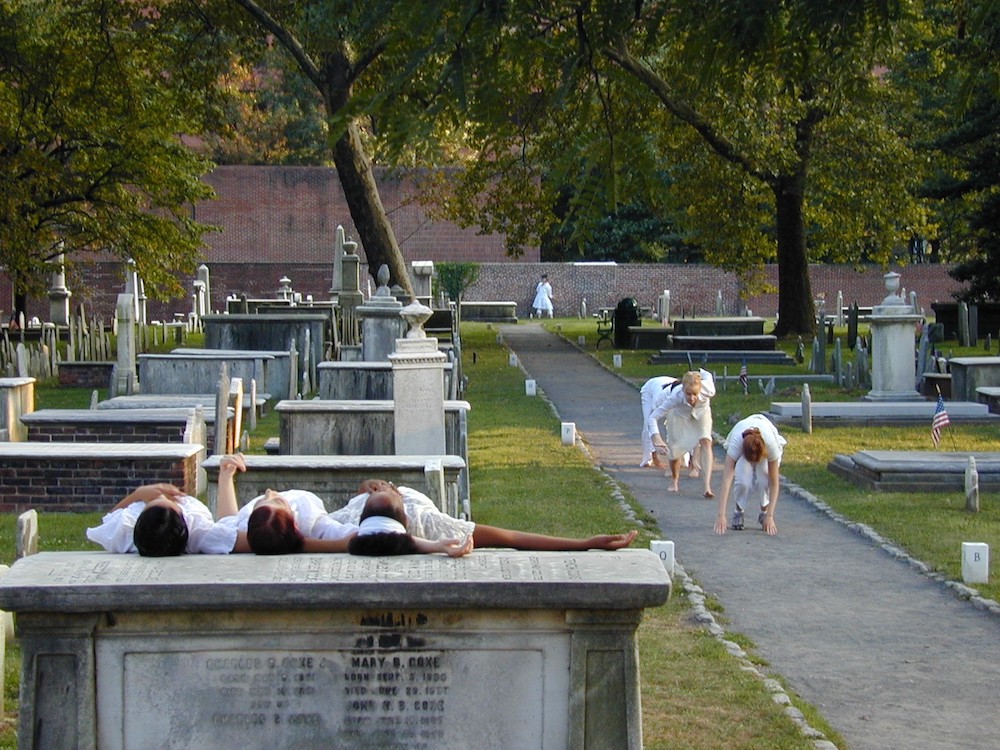
Corner Stone (2004), Christ Church Burial Ground, Philadelphia by Leah Stein, dancers: Michele Tantoco, Michelle Fenner, Tamara Xavier, Jenny Sawyer, Shavon Norris + 2 others, Photo: Leah Stein
LS: That has been my interest as well; creating an experience that illuminates through movement and sound the interconnectedness of ourselves and our environments, and the histories and stories that permeate place. My work has been seeped in listening to the natural, cultural, and personal stories, seen and unseen in a range of locations, without telling a specific narrative story, while responding to contradictions, collisions and weaving of energies that connect people and place. I ask myself if I have done justice to the voices of indigenous and enslaved people who were erased in these sites. I am committed to asking questions about site access, embodiment and questioning my own unintended participation in furthering the culture of erasure.
JS: Your point resonates with Koplowitz’s chapter on the site as inspiration for the work where he speaks about de-centering the artist's voice in site work.
LS: Yes, site work is inherently collaborative and activates the physicality of place, the history, the perspective of the artists involved and the audience–chosen or random. And, I appreciate the idea of decentralizing the artist view that several artists exemplify. For example, Martha Bowers immersed herself in the Red Hook community in Brooklyn and she says: “The content was really determined by them, and then how we can enlarge that–expand that.”
I think about how much site work is about relationships. Relationships between the site and the artist, the site and its community (past/present), the artists and their communities, etc. Even with a solo work, Eiko Otake’s Body in Places, where she, Japanese born, brings forward the grief of war and loss in the land of the site, or Pope L’s Crawl Project where he, a Black man, crawled through the streets of NYC (Times Square Crawl 1978, The White Man’s Crawl 2001-2009, and then expanded to all people, anyone, in Conquest 2019)–the site and the performer are deeply in relationship.
JS: In recognizing the impact of imposing an artist’s work on a site’s related communities Koplowitz emphasizes their inclusion and engagement.
LS: I think about, for example, Joanna Haigood’s extensive research into the history of escaping slaves at Jacob’s Pillow which led to her work Invisible Wings. Koplowitz was at the premiere and wrote, “Most people who walk through the fields and along the dirt paths surrounding the Pillow would never have known this history had it not been uncovered and rediscovered in her work.”
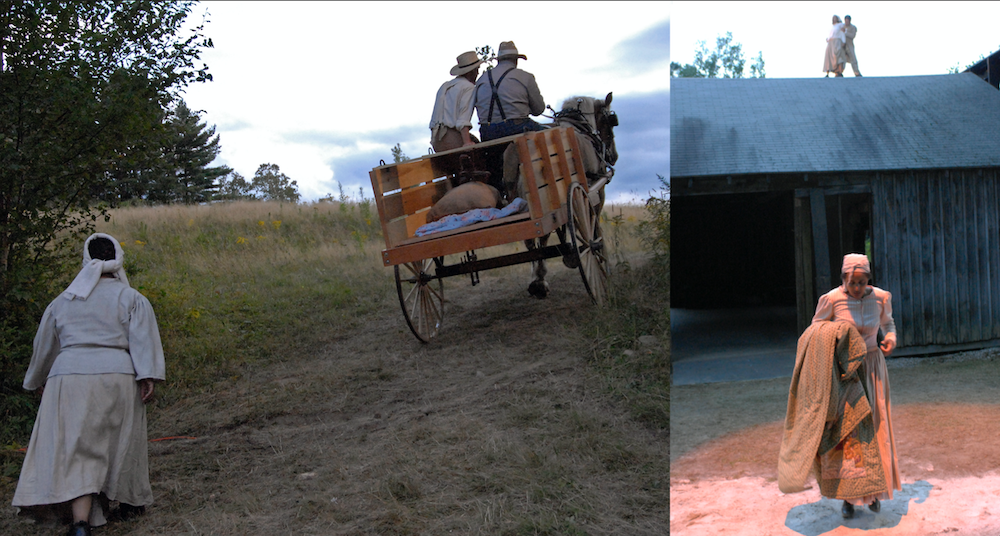
Invisible Wings (2007) by Joanna Haigood, Jacob’s Pillow, Beckett, MA. Photo © Nancy Palmieri, courtesy Joanna Haigood
When we were working at Eastern State Penitentiary, I very much wanted to bring to light issues of incarceration and the invisibility of people in prison. Also, I like to pay attention to “ghosts” in a space, the energies that remain from the past and bring them to the fore.
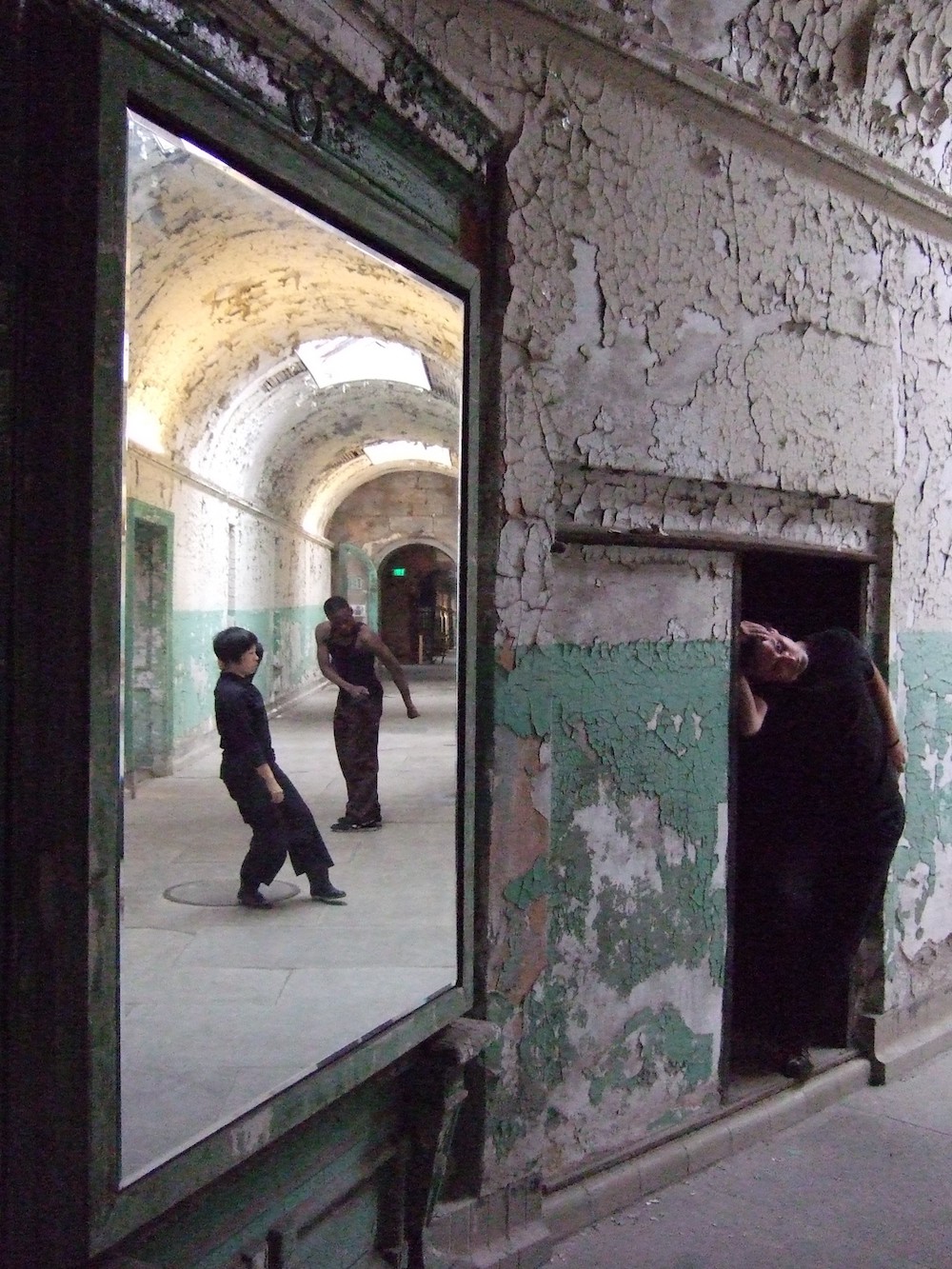
Gate (2007), Eastern State Penitentiary National Historic Site, Philadelphia, by Leah Stein, dancers: Roko Kawai, Jaamil Olawale Kosoko, David Konyk, Photo: Courtesy of Leah Stein
JS: I especially found resonant Koplowitz’s observations concerning the conceptual design for the site as including how the audience will experience the physical site, what he calls “audience design.” He quotes Jennifer Munson about her site work, Bird Brain: “…The audience’s experience was foregrounded… Every performance had a movement workshop with the audience… using simple sensory and spatial awareness exercises… I asked them to watch the dance as though they are watching the rest of the environment… just like they might with a bird, animal and other parts of the environment.” Having been in your own site performances, Leah, I know how much care you have given to this element.
LS: Considering the audience is key for me, imagining their pathways and perspective and how the performance can invite the audience in. In Gate, at Eastern State Penitentiary Historic Site, the audience was divided into four groups, with the intention that people would be separated from those they came with, to give the audience a feeling of leaving those they care about, a subtle gesture to being in prison. Also, in Bardo on an abandoned lot on South Broad Street across from the Kimmel Center, the audience sat on stools and rotated a full 360, following the performance that began at dusk and ended at nightfall. Even if the audience's “design” is loose, less “designed,” the consideration of the audience is an aspect inherent in site work.
I really appreciate the Monson quotes from Bird Brain and her invitation to the audience to be in the environment with them. Often, my intention has been to slow down the audience, as we the performers are slowing down to notice and feel and sense the interconnections of ourselves and the surroundings, and the continuum of sound and movement, and giving time for all the senses to be activated. I also especially enjoy the element of surprise, and when things happen unexpectedly, because this also heightens the connections among the performers, the site, and the audience.
JS: This relates to Koplowitz’s insights in having the site be an inspiration for the work, or in the quoted words of Tabor-Smith, the site “as a collaborator.” I like how he illuminates all aspects of this collaboration by urging a comprehensive “inventory” of physical, visual and sound components, of histories, architecture, environment, ownership and uses. How did this strike you?
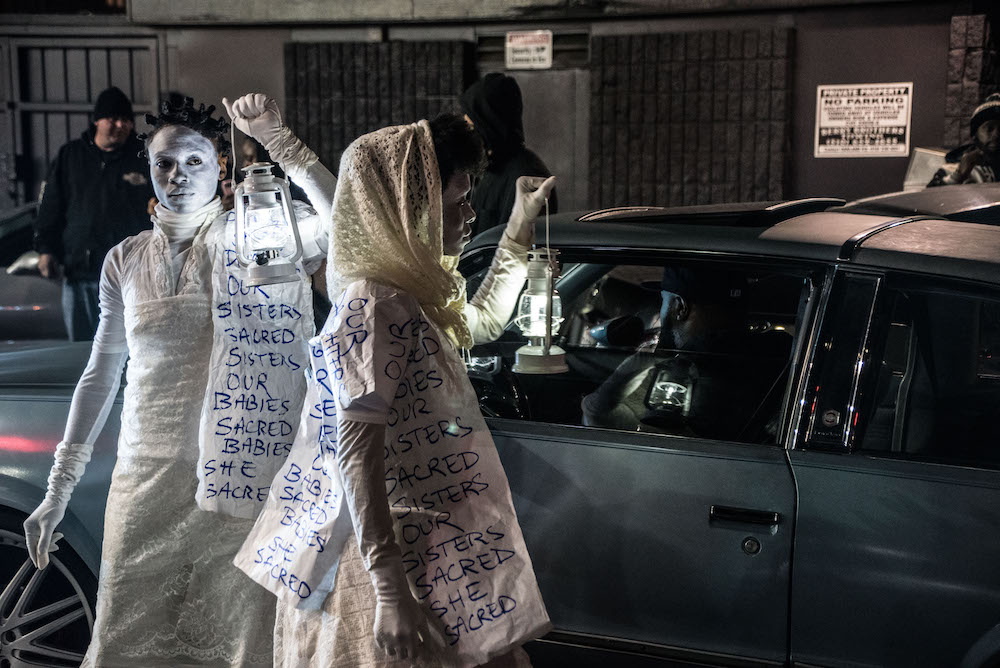
House/Full of Black Women (2017) created by Amara Tabor-Smith in collaboration with Ellen Sebastian Chang, downtown Oakland, CA, Photo © Robbie Sweeny, courtesy Amara Tabor-Smith.
LS: Absolutely, I think of being in partnership with the site, we learn from each other together, what is possible, seen / unseen, heard, felt, etc. I feel the “inventory process” Koplowitz mentions is quite experiential more than mental, and through exploration, the learning and shaping of ideas and choices develop.
Yet I don’t recall if Koplowitz or anyone talks much about improvisation in the process of exploring site. As my key approach to developing work, I am always curious about where improvisational practice lives for generating performance works for other site artists.
JS: Much of the book documents Koplowitz’s international career to illustrate his many points of advice, and in doing so is a kind of personal memoir. But a particular strength of the book is his inclusion of insights from almost two dozen other artists. For example, Debra Loewen offers: “I like getting lost in the process of trying to figure out how a space speaks to me or will speak to an audience… Listening to the site leads to acts of discovery.” Or from Haigood: “…As a site artist, I feel I have an opportunity to be an explorer in nature, in built environments and in histories.”
LS: I always enjoy arriving at the site with no or little agenda, except to pay attention and begin to explore, notice, listen to acoustics, feel the tones and textures and structures, movement, sounds simply present. This process reveals more and more, and combined with historical research and learning from people connected to the site, the process is quite layered and dynamic.
JS: Beyond the conceptual and aesthetic ideas, this book also exhaustively lays out the nitty-gritty of all aspects of site-work production, including recognizing the site choreographer as producer. Koplowitz, as an example, includes a chapter on fundraising for the artistic plan, something infrequently rendered explicitly and transparently amongst artists. Did you find this focus and advice useful?
LS: Yes, a couple sections on support and documentation may have been helpful to me early on in making site work. And his section on caring for dancers is also something to highlight in site work. There are risks to site work, and giving priority to dancers’ safety and well-being is really important to me. In terms of Koplowitz’s advice, I know that I was stubborn in a certain way early on and had to learn the hard way, through failing or experiencing setbacks. These experiences made me understand certain challenges of site work, such as audience preparation, design and communication as well as why it would be better for everyone not to overlook certain kinds of preparation, production concerns, division of labor, and the challenges of documentation for site work.
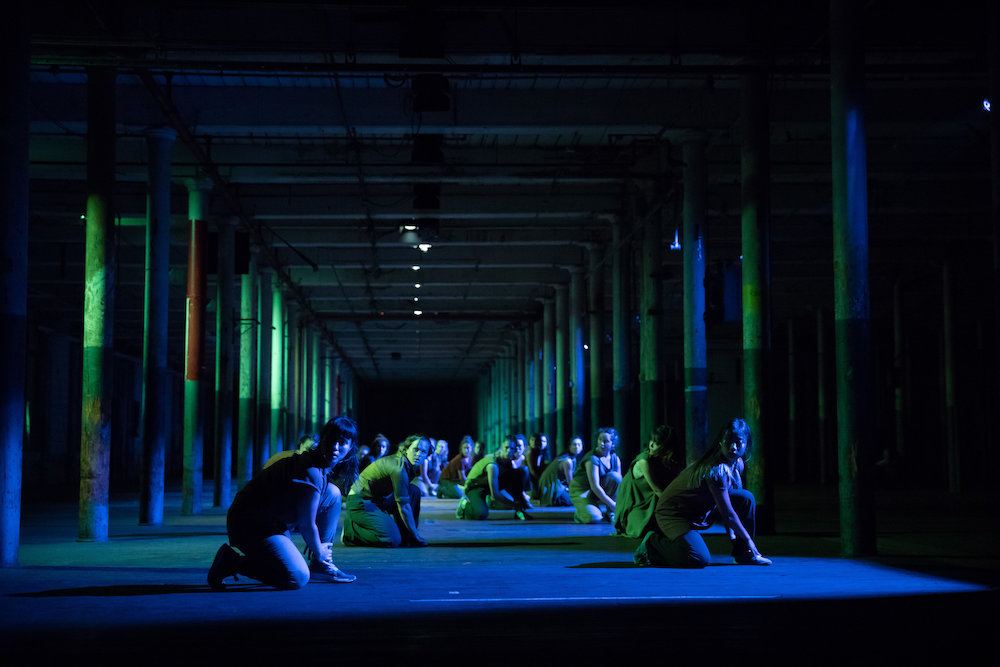
Mill Town (2017) by Stephan Koplowitz, photo copyright Jonathan Hsu.
JS: Having performed in Koplowitz’s first major site work, reprised at 30th Street Station, Philadelphia as Fenestrations 3.0 (1991), I valued the book’s description of his thematic inspiration and spatial concepts for this work of 36 dancers performed within the five stories of three-foot wide catwalks of the glass enclosed western wall of the station. I also thought that I as a performer might have loved to hear this as part of the rehearsal process at the time. But then again, am I right that more often than not choreographers tend to explore little of their conceptual planning with performers as they focus on getting the details of the performance correctly executed?
LS: What performers know and understand about concepts, motivations, images, metaphors-- I think there is the micro and macro. I try to share both, but I am usually the one keeping track of the macro and how everything interrelates so the performers are free to delve into the micro. I think the more the artists involved know the better, so they are invested, and feel their own agency. I think it’s more satisfying for everyone, and enriches the work, when the dance artists are able to internalize the ideas, generate their own way of responding, and contributing, if not asked to share their own perspective and choices.
JS: Koplowitz’s stated goal of his book is as a practical guide to “support, encourage and increase site production to develop a greater diversity of voices in the field.” Do you think that the book will achieve this?
LS: I see this book as a great resource in colleges and universities. The expansive list of about 80 artists in the field could really help young site artists find their own interests and voices. This is the kind of manual one can return to again and again for references, tips, and ways to refresh.
Many of the ideas in the book are also relevant for all dance making, site-specific or otherwise. It makes me wonder if this book were used by artists for performances working in the theater, would proscenium stage work change? I think of Germaine Ingram; she may not identify as a site artist per se, but her work extensively draws from so many frames of inquiry; it activates and inhabits questions that relate to multiple layers of a specific site or location or history.
This book may become a lasting resource that far expands the conversation.
*Kloetzel was a former Swarthmore College student of Leah Stein and a dancer in her site work.
Stephan Koplowitz, On Site: Methods for Site-Specific Performance Creation (Oxford Univ. Press 2022).
Site Photo:Occupy section 5 (2017) by Stephan Koplowitz, Yerba Buena Gardens, San Francisco, CA, photo copyright George Simian, Bottom: Play(as) (2015) by Stephan Koplowitz Waterfront Park, San Diego, CA, photo copyright Stephan Koplowitz
Article Photo: Fenestrations 3.0 (1991) at 30th Street Station, Philadelphia, photo Stephan Koplowitz
By Jonathan Stein
August 20, 2022


